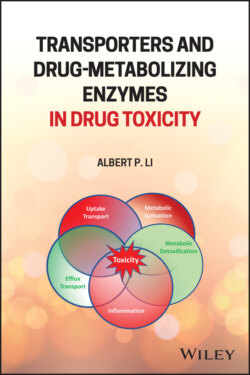Читать книгу Transporters and Drug-Metabolizing Enzymes in Drug Toxicity - Albert P. Li - Страница 23
2.2.1 Phase I Metabolism
ОглавлениеWithin phase I metabolism a series of biotransformation reactions, including oxidation, hydroxylation, and other reactions, are triggered. These reactions add functional hydroxyl, carboxyl, amino, or thiol groups to lipophilic drugs and convert them to a more hydrophilic status. This process is primarily mediated by the cytochrome P450 (CYP) enzymes, which account for about 75% of the total metabolism in the liver. CYP is a large family of enzymes containing heme as a cofactor. They function as monooxygenases localized primarily in the membrane of the endoplasmic reticulum (ER) in hepatocytes. In humans approximately 60 genes coding for the various CYP enzymes have been identified. The most frequent human P450 isoforms involved in the metabolism of drug molecules are 3A4/5, 2D6, 2C9, 1A2, 2B6, 2C19, 2C8, 2A6, 2E1, and 2J2 (Figure 2.2) [6]. CYP3A4/5 and 2D6 are the most abundant of all CYP450 enzymes in the human liver and metabolize half of medications, although their expression levels vary widely among individuals.
Figure 2.2 The most frequent human P450 enzymes involved in metabolism of clinically‐used drugs. Numbers represent the fractions of drugs metabolized by the P450 enzyme.
Source: Data from Zanger and Schwab [6].
The expression level of these CYP enzymes controls the rate at which many drugs are metabolized. Usually a drug is metabolized by multiple CYP enzymes. Each of these has a limited capacity to metabolize drugs, and therefore can become overloaded when the drug level in blood is too high. The activities of the CYP enzymes significantly vary among individuals, and their gene expression and enzyme activities are tightly regulated by members of the nuclear receptor (NR) family of ligand‐modulated transcription factors, such as the pregnane X receptor (PXR), farnesoid X receptor, vitamin D receptor, and hepatocyte nuclear factor 4 alpha.
